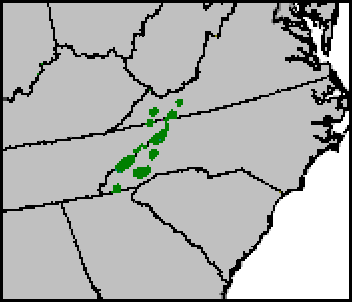Fraser Fir
(Abies fraseri)
Fraser Fir is a mid-size coniferous tree found at the highest elevations of the southern Appalachian mountains. Like other firs, it has flat evergreen needles, up-pointing cones, and a narrow pyramidal form. The needles are shiny dark-green with two silvery-white bands on the lower surface, and the cones change from dark purple to gray-brown as they mature. Where it can be grown, the tree makes a very ornamental landscape plant.
Unfortunately, over the past few decades the wild population of this species has been devastated by an infestation of an accidentally-imported insect called the balsam woolly adelgid. By some estimates, at least 80% of the mature trees in the plant's native range have died. Some scientists believe that the effects of acid rain and air pollution have exacerbated the problem.
The insects suck nutrients from an infested tree, which reacts by forming very dense wood that blocks sap flow. Luckily a small percentage of mature trees appear to react less strongly and are withstanding the attack. Young trees also show less effect, and many of them become old enough to produce seeds before beginning to decline. For these reasons there is hope that the wild population can ultimately overcome the threat, and scientists are looking for ways to help.
There are (or were) nearly pure stands of this tree on some of the highest peaks in its range. Today the skeletons of thousands of dead trees can be seen, usually mixed with young specimens and perhaps a few older survivors. At slightly lower elevations the species forms mixed stands with Red Spruce (Picea rubens), but here also most of the mature firs are dead.
Fraser Fir can make an attractive landscape plant, but it is difficult to grow in most areas. It needs a cool moist climate and well-drained acid soil, and is susceptible to drought, pollution, root rot, and attacks from several types of insects. It does best in full sun, but even there grows rather slowly.
In some areas this plant is grown commercially to supply the market for Christmas trees. In fact, because of its ornamental qualities and its good needle retention, it is generally regarded as the best Christmas tree species.
Other Information
Scientific Name: Abies fraseri
Common Names: Fraser fir, southern balsam fir, she-balsam
Plant Type: Mid-size evergreen coniferous tree
Height: 30 to 60 feet
Cultivation Zones: 4 - 6
Native Range: Highest elevations of the southern Appalachian mountains in western North Carolina, southwestern Virginia, and extreme eastern Tennessee. Generally occurs as disjoint populations on the upper slopes of the highest peaks, usually above 5000 feet. See map below.
Distribution Map

Range Map Source: U.S. Forest Service. (See General Note C)
Conservation Status: NatureServe lists Abies fraseri as Critically Imperiled in Virginia, Imperiled in North Carolina, and Critically Imperiled or Imperiled in Tennessee.
Cultivation: Fraser Fir needs a cool moist climate and a well-drained acid soil. Though somewhat shade-tolerant, it has a better form in sun. Because it is slow-growing, little pruning is needed, and it generally looks best if allowed to grow naturally with its branches sweeping the ground. Go to Cultivation for more information.
Related Species: This species is closely related to the more northern Balsam Fir (Abies balsamea) In fact Fraser Fir most likely evolved from Balsam Firs that migrated southward during the Ice Ages.
Plant Sources: Abies fraseri can be difficult to find. Possible sources include Musser Forests and Forest Farm. In some areas you might be able to obtain the plant from a commercial Christmas tree grower. Possible sources of seeds include F. W. Schumacher Company and Sheffields Seeds. For links to the mentioned suppliers, go to Sources of Plants.
|

